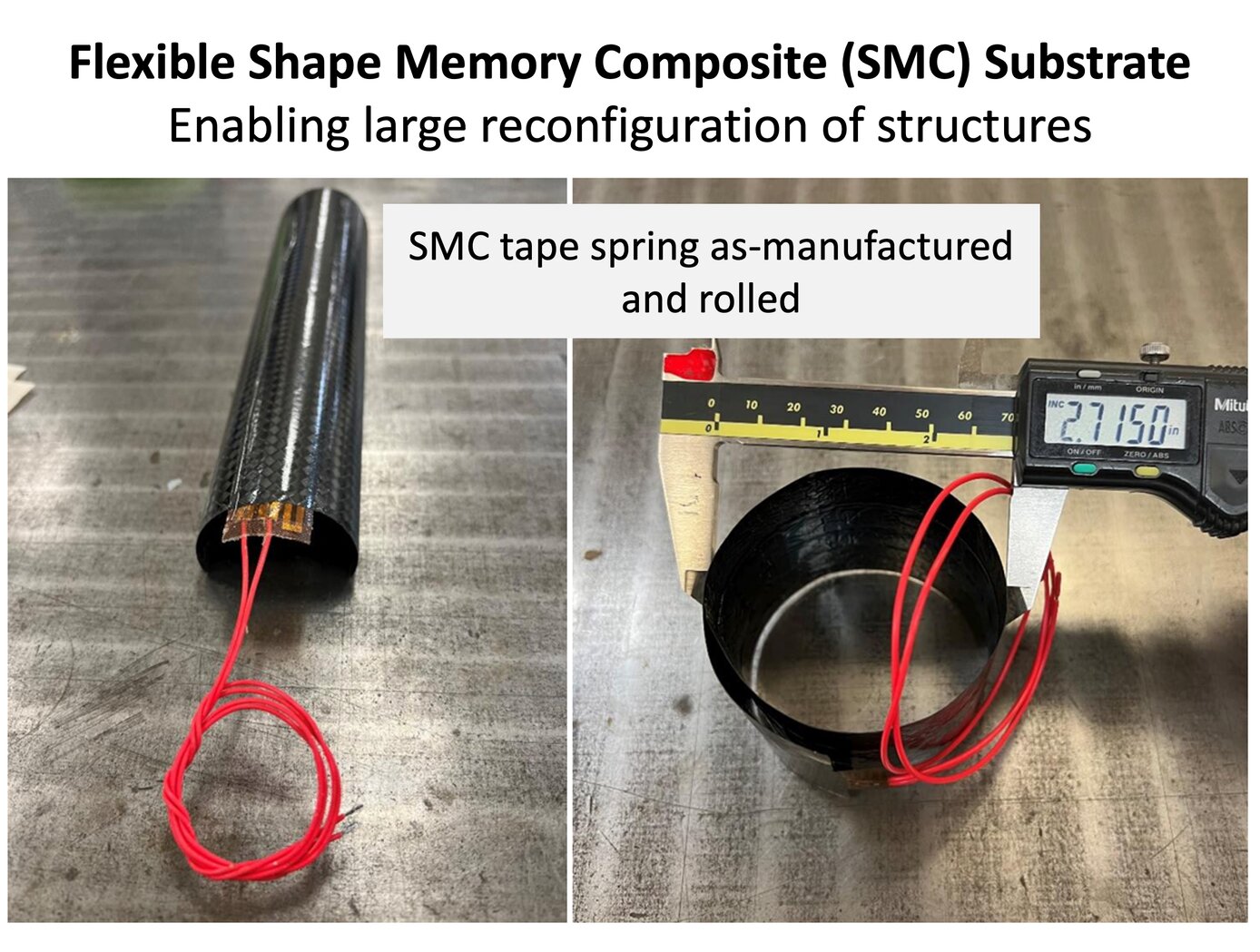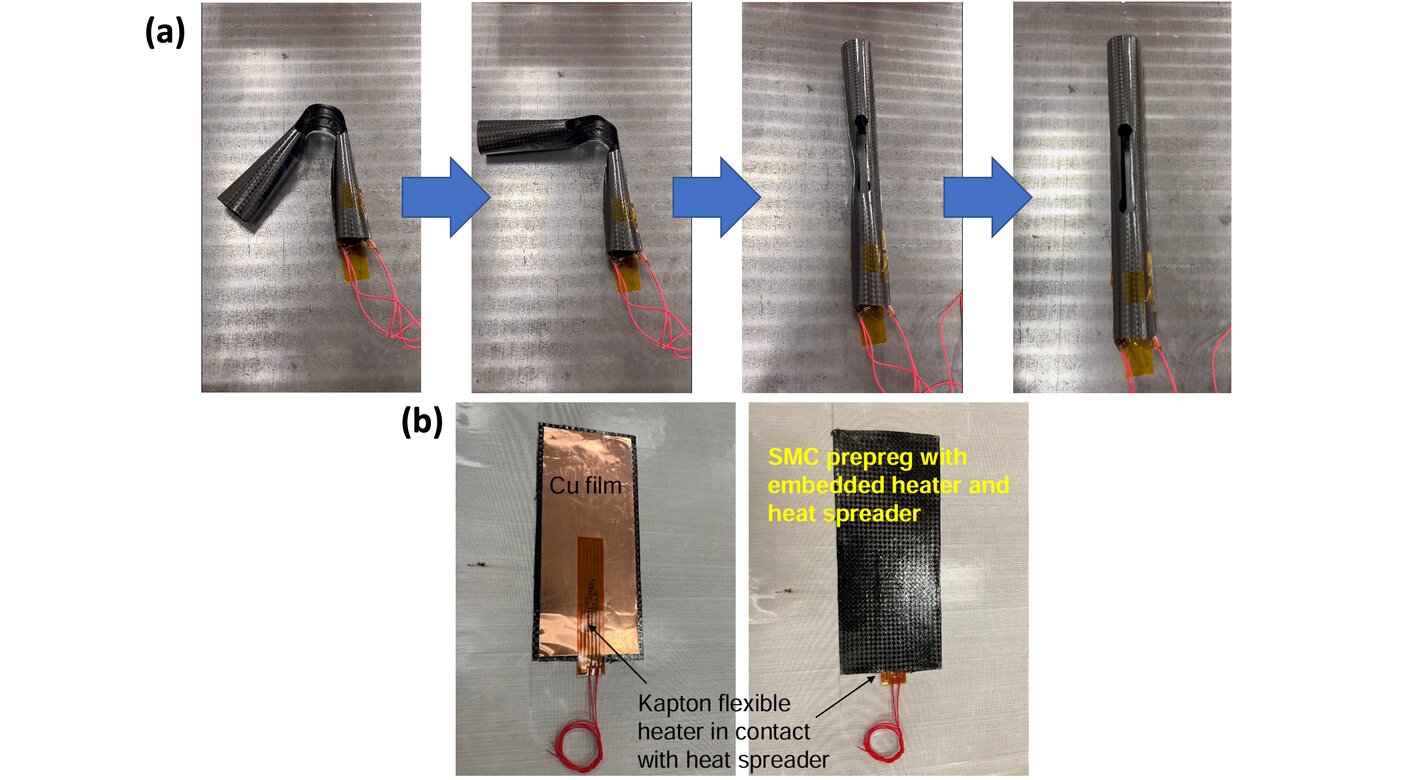Novel Shape Memory Composite Substrate
Materials and Coatings
Novel Shape Memory Composite Substrate (LAR-TOPS-379)
Enabling Efficient Actuation of Deployable Structures
Overview
Shape memory polymers, like shape memory alloys, have the capability to return to their original shape from a temporary (or programmed) shape when some external stimulus is applied (e.g., temperature, electric field). However, shape memory polymers have not seen the same level of implementation as the alloys because (1) they do not have high actuation forces (i.e., the force of the shape change) and (2) the polymers do not spread stimuli well, as such, the actuation is not constant across the material.
NASA inventors have developed a novel shape memory polymer composite (SMC) substrate by combining a shape memory polymer with thin carbon fiber sheets and an in-situ heating mechanism. The in-situ heating and a carbon fiber layer result in heat being spread evenly across the polymer and significantly higher actuation forces compared to the polymer alone. The capabilities of the composite substrate will enable deployable systems across various industries.
The Technology
The new SMC substrate has four components: a shape memory polymer separately developed at NASA Langley; a stack of thin-ply carbon fiber sheets; a custom heater and heat spreader between the SMC layers; and integrated sensors (temperature and strain). The shape memory polymer allows the as-fabricated substrate to be programmed into a temporary shape through applied force and internal heating. In the programmed shape, the deformed structure is in a frozen state remaining dormant without external constraints. Upon heating once more, the substrate will return slowly (several to tens of seconds) to the original shape (shown below).
The thin carbon fiber laminate and in situ heating solve three major pitfalls of shape memory polymers: low actuation forces, low stiffness and strength limiting use as structural components, and relatively poor heat transfer. The key benefit of the technology is enabling efficient actuation and control of the structure while being a structural component in the load path. Once the SMC substrate is heated and releases its frozen strain energy to return to its original shape, it cools down and rigidizes into a standard polymer composite part. Entire structures can be fabricated from the SMC or it can be a component in the system used for moving between stowed and deployed states (example on the right). These capabilities enable many uses for the technology in-space and terrestrially.


Benefits
- Increased structural capabilities: the SMC substrate can be used as a load-bearing component in larger structure (not possible with shape memory polymers).
- Improved actuation and heat distribution: the carbon fiber backbone and the in-situ heating increase the actuation force and ensuring that the shape change occurs evenly.
- Controllable actuation: integrated temperature and strain sensors allow for controlled heating and shape change sensing of the SMC.
- Reduced mass and volume: the SMC substrate does not require an external mechanical deployment mechanism or other stowage constraints like typical deployable systems.
- Reduced complexity and part count: removing additional stowage and deployment mechanisms significantly reduces the complexity and risk of the system.
Applications
- Aerospace: stowable and deployable hinges, tape-springs, booms, solar arrays, antenna supports, habitat frames
- Defense: actuators to enable deployable tent/shelter structures, solar panels, antennas mounts, and camera or sensor poles
- Automotive: actuators or larger components (e.g., body panels) that are activated/repaired with heat
- Other industries: various actuators (e.g., appliances or medical devices)
Technology Details
Materials and Coatings
LAR-TOPS-379
LAR-20352-1
|
Tags:
|
Similar Results

Innovative Shape Memory Metal Matrix Composites
Shape memory alloys (SMAs) are metals that can return to their original shape following thermal input. They are commonly used as functional materials in sensors, actuators, clamping fixtures and release mechanisms across industries. SMAs can suffer from dimensional/thermal instability, creep, and/or low hardness, resulting in alloys with little to no work output in the long term. To combat these deficiencies, NASA has developed a process of incorporating nanoparticles of refractory materials (i.e., carbide, oxide, and nitride materials with high temperature resistance) into the alloys.
Using various processing methods, the nanoparticles can be effectively mixed and dispersed into the metal alloys as shown in the figure below. In these processes the SMA and refractory material powder is mixed and the refractory nanoparticles incorporated through extrusions, melting, or directly used in additive manufacturing to create parts for applications across the aerospace, automotive, marine, or biomedical sectors. The nanoparticle dispersion is a controllable method to strengthen the SMAs, increasing the hardness of the alloys, reducing the impact of creep, and improving the overall dimensional and thermal stability of the alloys.
The related patent is now available to license. Please note that NASA does not manufacture products itself for commercial sale.

How to Train Shape Memory Alloys
Glenn researchers have optimized how shape memory alloys (SMAs) are trained by reconceptualizing the entire stabilization process. Whereas prior techniques stabilize SMAs during thermal cycling, under conditions of fixed stress (known as the isobaric response), what Glenn's innovators have done instead is to use mechanical cycling under conditions of fixed temperature (the isothermal response) to achieve stabilization rapidly and efficiently. This novel method uses the isobaric response to establish the stabilization point under conditions identical to those that will be used during service. Once the stabilization point is known, a set of isothermal mechanical cycling experiments is then performed using different levels of applied stress. Each of these mechanical cycling experiments is left to run until the strain response has stabilized. When the stress levels required to achieve stabilization under isothermal conditions are known, they can be used to train the material in a fraction of the time that would be required to train the material using only thermal cycling. As the strain state has been achieved isothermally, the material can be switched back under isobaric conditions, and will remain stabilized during service. In short, Glenn's method of training can be completed in a matter of minutes rather than in days or even weeks, and so SMAs become much more practical to use in a wide range of applications.

Precipitation Strengthened
Ni-Ti-Pd Shape Memory Alloys
Shape memory alloys (SMAs) are metals that can return to their original shape following thermal input and are largely used as actuators for various applications across industries including space, aeronautics, automotive, and biomedical. These alloys can require long processing times to stabilize through repeated training cycles and suffer from loss of strength and stability during use. Precipitation strengthening (using heat treatments to grow small nanoscale regions of distinct metal phases within the base alloy) is one way to mitigate these issues.
The NASA inventors have combined a modification of typical NiTi compositions by introducing Palladium (Pd) and small amounts of other metals and specific heat treatments to produce a novel SMA with improved properties. Specifically, the alloy is inherently stable, reducing both the need for extended processing times to stabilize the metal and the possibility of failure during high numbers of actuation cycles. Further, the SMA is specifically designed to have significantly lower hysteresis (the temperature difference between the heating and cooling) than current state of the art SMAs, i.e., at or below 10°C compared to 20°C or above. These properties combine for a SMA with enhanced properties usable across various industries and applications for reliable actuation.
The related patent is now available to license. Please note that NASA does not manufacturer products itself for commercial sale.

Shape Memory Alloy Art (SMArt)
A prototype device has been developed at Glenn for creating shapes from SMA wire. The apparatus uses material feedstock in spools made of alloys that exhibit the shape memory effect (temperature-induced activation), super elasticity (stress-induced activation), and to some extent, magnetism (magnetically-induced activation). The feedstock (e.g., wire spool) is routed and positioned around a series of modular pins to create a shape outline. Once the desired shape is formed, the wire ends are clipped from the feedstock and secured into a locking mechanism, then connected to a heating circuit (e.g., joule heating, hot plate, heat gun). The programmable prescribed circuit parameters, including current or temperature and training time, are set and confirmed using the apparatus control dials and indicators to ensure safe and accurate operation of the device. Before enabling the circuit, a plastic shield is placed over the modular array to protect the operator. The final product will be a desired shape that can be deformed and recovered numerous times through heat activation.

Shape Memory Alloy Rock Splitters (SMARS)
Glenn's revolutionary SMARS device is fabricated from nickel-titanium-halfnium (NiTiHf), nickel-titanium-zirconium compositions, or a combination. These compositions contain a secondary, nanometer-sized precipitate phase, which is produced through processes of compositional control and ageing heat treatments. Glenn's novel materials and processes have yielded a SMA composition that produces much higher stresses than other SMAs on the commercial market.
The SMARS device is composed of 1) SMA material as the actuating member; 2) a casing heater placed around the SMA member; 3) a DC or AC power source to provide current through the heater; 4) pointed tips for acute penetration into rock formations; and 5) a hand-press to reset the SMA element after each use. In the rock-splitting process, a hole equal to the diameter of the SMA element is drilled in the portion of the rock where the fracture is desired. Next, the pre-compressed SMA is inserted into the hole, and AC or DC current is applied to energize the devices heaters. Once the heater achieves the critical transformation temperature, the SMA will begin to expand within seconds. Since its expansion is constrained by the rock walls, the SMA will eventually exert up to 1500 MPa of stress, splitting the rock apart. When the current is removed and the heater cools, the SMA material returns to its pre-compressed state. At this point, the material can be recovered, so the process is repeatable after reshaping. The SMA actuating members were also designed to achieve displacement greater than the materials strain output. Glenns SMARS device provides high-powered rock fracturing that is controllable, reliable, and comparatively simple without the use of explosives, hydraulics, or chemicals.



